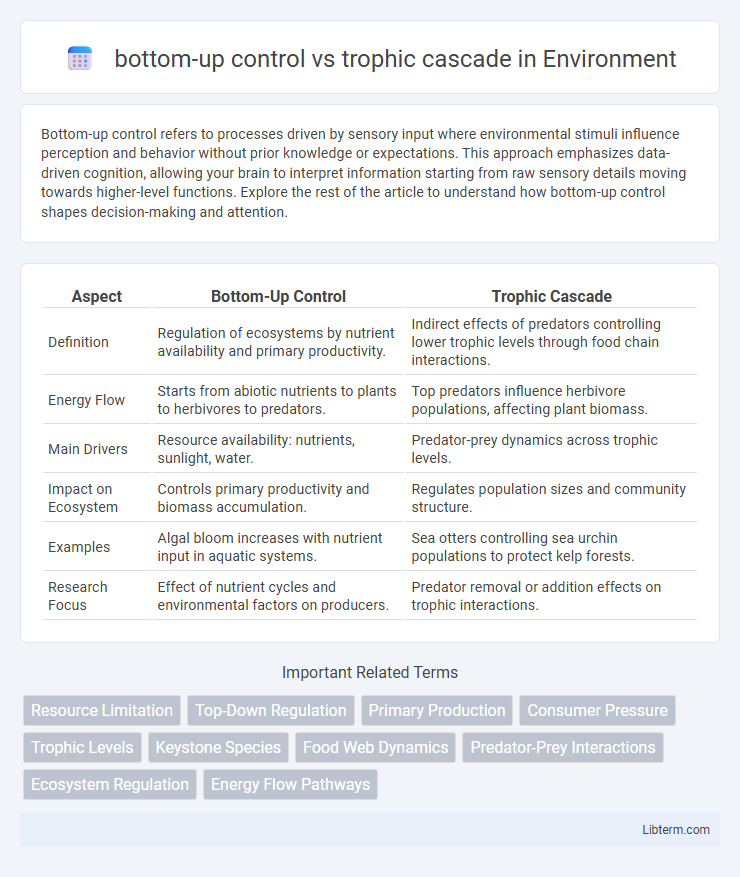Bottom-up control refers to processes driven by sensory input where environmental stimuli influence perception and behavior without prior knowledge or expectations. This approach emphasizes data-driven cognition, allowing your brain to interpret information starting from raw sensory details moving towards higher-level functions. Explore the rest of the article to understand how bottom-up control shapes decision-making and attention.
Table of Comparison
| Aspect | Bottom-Up Control | Trophic Cascade |
|---|---|---|
| Definition | Regulation of ecosystems by nutrient availability and primary productivity. | Indirect effects of predators controlling lower trophic levels through food chain interactions. |
| Energy Flow | Starts from abiotic nutrients to plants to herbivores to predators. | Top predators influence herbivore populations, affecting plant biomass. |
| Main Drivers | Resource availability: nutrients, sunlight, water. | Predator-prey dynamics across trophic levels. |
| Impact on Ecosystem | Controls primary productivity and biomass accumulation. | Regulates population sizes and community structure. |
| Examples | Algal bloom increases with nutrient input in aquatic systems. | Sea otters controlling sea urchin populations to protect kelp forests. |
| Research Focus | Effect of nutrient cycles and environmental factors on producers. | Predator removal or addition effects on trophic interactions. |
Introduction to Ecosystem Regulation
Bottom-up control emphasizes the influence of nutrient availability and primary producers in regulating ecosystem productivity and structure. Trophic cascades describe top-down effects where predators indirectly control lower trophic levels, impacting community composition and nutrient cycling. Understanding these mechanisms is essential for ecosystem management and predicting responses to environmental changes.
Defining Bottom-Up Control
Bottom-up control refers to ecosystem regulation where nutrient availability and primary production dictate the abundance and distribution of higher trophic levels. This concept emphasizes how the quantity and quality of resources, such as light and minerals, influence the growth of primary producers, subsequently affecting herbivores and predators. Understanding bottom-up control is crucial for predicting ecosystem responses to environmental changes and nutrient cycling dynamics.
Understanding Trophic Cascades
Trophic cascades occur when predators indirectly regulate the abundance and distribution of organisms at lower trophic levels through top-down control mechanisms. Bottom-up control emphasizes how nutrient availability and primary productivity shape ecosystem structure by influencing herbivore and predator populations. Understanding trophic cascades requires analyzing the interplay between these controls to reveal how energy flows and species interactions stabilize or disrupt ecosystem dynamics.
Key Differences Between Bottom-Up and Top-Down Processes
Bottom-up control emphasizes nutrient availability and primary productivity as the foundation shaping ecosystem structure, influencing herbivore populations and higher trophic levels directly through resource limitation. In contrast, trophic cascades represent top-down processes where predators regulate the abundance and behavior of prey, indirectly affecting primary producer communities by controlling herbivore numbers. Key differences include the direction of control--bottom-up processes initiate from abiotic factors regulating producers, while top-down cascades originate from predation pressure shaping ecosystem dynamics across trophic levels.
Primary Producers and Resource Availability
Bottom-up control emphasizes the influence of resource availability, such as nutrients and light, on the abundance and productivity of primary producers in an ecosystem. In contrast, trophic cascades highlight how changes in higher trophic levels indirectly affect primary producers by altering herbivore populations. Efficient management of nutrient inputs can thus regulate primary production and ecosystem stability through bottom-up mechanisms.
Predator Influence and Trophic Dynamics
Predator influence in trophic dynamics primarily shapes food web structure through top-down control, regulating prey populations and cascading effects across multiple trophic levels. Bottom-up control arises from resource availability, where primary productivity and nutrient supply determine ecosystem energy flow and population sizes. The interplay between predator-driven top-down forces and resource-mediated bottom-up mechanisms governs trophic cascade intensity and ecosystem resilience.
Real-World Examples of Bottom-Up Control
Bottom-up control in ecosystems is exemplified by nutrient availability limiting primary producer growth, as seen in aquatic systems like Lake Washington where phosphorus input reduction led to decreased algal blooms and improved water clarity. In terrestrial ecosystems, nitrogen deposition influences plant biomass and herbivore populations, demonstrated by increased grass growth in prairies following fertilization. These cases contrast trophic cascades where predators regulate ecosystem structure, highlighting bottom-up forces driven by resource supply rather than consumer pressure.
Case Studies Demonstrating Trophic Cascades
Case studies demonstrating trophic cascades often highlight ecosystems where predator removal triggers significant shifts in herbivore populations and vegetation dynamics, such as the reintroduction of wolves in Yellowstone National Park leading to decreased elk overgrazing and vegetation recovery. In marine systems, the removal of apex predators like sharks has caused increases in mid-level consumers, resulting in declines in lower trophic levels, exemplifying top-down effects. These examples contrast with bottom-up control, where nutrient availability regulates ecosystem productivity, but trophic cascades emphasize predator-driven changes propagating through food webs.
Implications for Ecosystem Management
Bottom-up control emphasizes nutrient availability and primary productivity as drivers of ecosystem structure, indicating that managing nutrient inputs can regulate species populations and maintain ecosystem stability. Trophic cascades highlight the importance of top predators in shaping community dynamics, suggesting that preserving or restoring apex predator populations can prevent herbivore overpopulation and promote biodiversity. Integrating both approaches allows ecosystem managers to balance nutrient management with predator conservation, optimizing resilience and ecological function.
Integrating Bottom-Up and Top-Down Perspectives
Integrating bottom-up control and trophic cascade perspectives reveals the dynamic interactions between resource availability and predator effects within ecosystems. Nutrient supply and primary productivity regulate the biomass of lower trophic levels, while predators exert top-down pressure that propagates through trophic cascades, influencing community structure and ecosystem function. Combining these approaches enhances predictions of ecosystem responses to environmental changes by accounting for both nutrient-driven resource limitations and consumer-driven feedbacks.
bottom-up control Infographic

 libterm.com
libterm.com